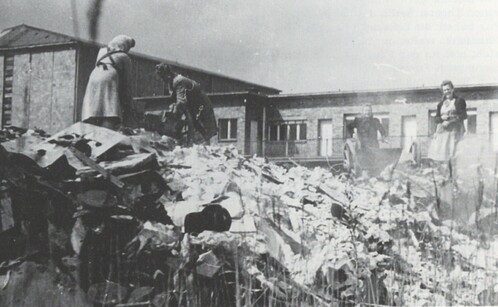- Home
- POSTER GALLERY
- ❗️BOOK & POSTER STORE❗️
- PURCHASE "HJ Quex" film ephemera HQ
- About the Posters
- The William Gillespie Collection
- Our Publishing House
- ❗️GFDN interviews author and collector William Gillespie ❗️
- Our most expensive & inexpensive finds!
- ❗️***NEW!**❗️POSTER OF THE MONTH - Blutzeugen / Raza
- ❗️NEW ❗️Film Posters – Demands on an important means of film advertising. ❗️
- In our Book + Zeitschrift Library
- ❗️ ***NEW!*** Hitler Youth Quex – A Guide for the English–speaking Reader ***NEW!*** ❗️
- ❗️***NEW!*** Table of Contents of our new HJ QUEX book❗️
- ❗️Hitler Youth Quex Guide - early praise! ❗️
- Recent loans from the Collection
- Farewell Horst Claus. (1940–2024 †)
- "Der Deutsche Film" Zeitschrift
- ❗️ ***NEW!***Reichsfilmkammer collection ❗️
- German "Tendency" Films (Tendenzfilme) in the Third Reich
- KARL RITTER
- Karl Ritter original film posers in this Collection
- "Besatzung Dora" ( † 1943)
- "The Making of The Crew of the Dora"
- Karl Ritter at the 1938 Reichsfilmkammer Congress
- INDEX -"Karl Ritter" book, 2nd edition
- Karl Ritter's Legion Condor (1939, unfinished)
- Excerpt from our "Dora" book
- ∆∆∆∆∆ High praise for our DORA book! ∆∆∆∆∆
- TABLE OF CONTENTS – "Legion Condor"
- § § § § § Early Praise for our LEGION CONDOR book! § § § § §
- ❗️"Das Leben geht weiter" and Karl Ritter ❗️
- Dateline: Ufa - April 11, 1945
- Zarah Leander Europe–wide !
- Japan Military Film and Karl Ritter
- Karl Ritter after 1945
- 1935 Film Congress
- Poster Exhibition in Berlin, March 1939
- Potsdam poster exhibition 12 April–25 August 2019
- Leni Riefenstahl's two "Olympia" Films (1938)
- "Ohm Krüger" (1941)
- Emil Jannings
- "Blutendes Deutschland" (1933)
- Hannes Stelzer ( † 1944)
- Klaus Detlef Sierck ( † 1944)
- Film stills
- Reich Film Censorship Offices
- ❗️***NEW!***The Fate of the German Film Industry in May 1945 ❗️
- Film censorship cards
- Film Archives
- Cinema advertising
- School filmstrips
- ❗️UPDATED❗️ Z F O / Ostland Film G-m-b-H
- Z F O / Herbert Jacobi estate
- ZFO / Ostland Film newspaper articles
- ❗️***NEW!*** Roter Nebel / Red Fog / Red Mist (1942/1943, ZFO) ❗️
- ZFO - Der Rückkehrer - The Returnee (1943/1944)
- The D F G production company
- D I F U
- ❗️ ***NEW!*** "Carl Peters" – Special Collection. ❗️
- "Alcazar" (1940, Genina)
- "Der 5. Juni" (1943, banned)
- Herbert Selpin and his "Titanic" (1943)
- Ein Robinson (1940, Fanck)
- "Fronttheater" (1942)
- Veit Harlan's Jud Süß and Fritz Hippler's Der Ewige Jude
- Harlan "Jud Süß" trial 1949
- Werner Krauss & JUD SÜß
- Anti-Semitic Film Posters in the Collection
- "Heimkehr" (1941)
- "Hitlerjunge Quex" (1933)
- ❗️***NEW!*** Hitlerjunge Quex in 111 Greater Berlin Cinemas ❗️
- Jürgen Ohlsen
- "S.A.Mann Brand" (1933)
- "In der roten Hölle" (Edgar Neville, 1939)
- "Helden in Spanien" (1938)
- The Spanish Civil War in Film
- Andrews Engelmann (1901 – 1992)
- Deutsche Wochenschau
- Uƒa Feldpost
- Uƒa Kulturfilm – Informationen
- " Die Tochter des Samurai" (1937, Fanck)
- Ufa 25th Anniversary
- Invitations to world premieres
- ❗️***NEW!*** Continental Films, Paris 1940–1944 ❗️
- Film Censorship in Occupied Paris 1942
- "Der Sieg des Glaubens" (1933)
- Wilhelm Althaus Estate
- Weimar Germany posters
- Ufa and the Ordensburgen
- The Gaufilmstelle in our Collection
- "Zwei Welten" (1940)
- "Capriccio" (1938) –Karl Ritter film album
- Unrealised NS Propaganda Films 1934–1945
- German Film Directors accused of "war crimes"
- Australian––themed NS feature films
- "Der Störenfried" / "The Troublemaker"
- What was new in 2014?
- What was new in 2015?
- What was new in 2016?
- What was new in 2017?
- What was new in 2018?
- What was new in 2019?
- What was new in 2020?
- What was new in 2021?
- What was new in 2022?
- What was new in 2023 ?
- What's new in 2024?
- ❗️***NEW!*** Hitler assassination attempt in Karl Ritter film cut❗️
- BESATZUNG DORA private photos
- Just discovered 1942 article on BESATZUNG DORA
- The Karl Ritter Tetralogy
- Google Analytics 2023
- Our first–ever acquisition!
- ❤️"Some of our favourite things....!"❤️
- ERRATUM for our " Hitler Youth Quex Guide"
- Trending
- Vale †
- Our Wants List / 2024 / Wunschliste
- Pop Quiz
- Unsere KARL RITTER Bücher in Deutschland liefbar!
- WHERE to buy our books right now?
- ✉️Contact
 “History is not about the facts. It is about the context and who is telling the story.” —Prof. Milton Fine.
“History is not about the facts. It is about the context and who is telling the story.” —Prof. Milton Fine.
"Who controls the past controls the future: who controls the present controls the past." –– George Orwell in his novel "1984."
"Whoever doubts the exclusive guilt of Germany for the Second World War destroys the foundation of post–war politics." –– Prof. Theodor Eschenberg, Rector, the University of Tübingen.
"If we have our own why in life, we shall get along with almost any how." – Friedrich Nietzsche
POSTER GALLERY --view
over 500 German film
original posters between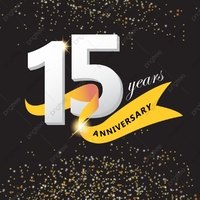
1927–1954 from
Germany and from
many Axis and Neutral countries
across Europe!
Note! Posters in the Poster Gallery are PERMANENT
acquisitions which are NOT FOR SALE!! ONLY the
posters listed in our POSTER STORE are for sale.
(They have a price and order button to use.)
Dateline: Uƒa on April 11, 1945
Thirteen days before the Soviets fought their way onto the Ufa film studio grounds of Ufastadt – Babelsberg, work by the remaining employees there was still underway. Many of the men were gone, being called up for either the Wehrmacht or the Volksturm. Nine months earlier, the number of employees working there tallied over 1,800.
We have acquired original documents from early 1945 from the Ufa files, which include this remarkable ledger page, indicating films being edited or re–edited on Wednesday, the 11th of April, 1945.
The sheet lists feature films and short films being edited in the Editing Hall (show below circa 1935) that day.
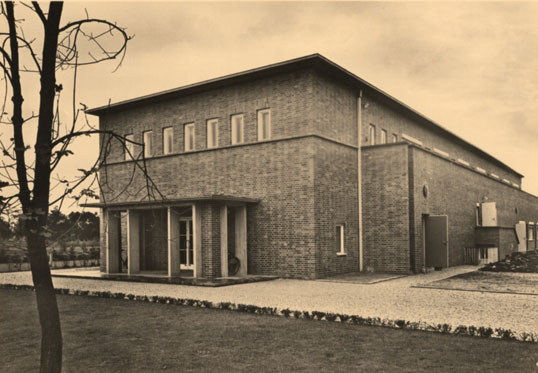
The editing facilities that day, as per the tally sheet below, were being used to work on two Veit Harlan Agfacolor films, Kolberg and Opfergang, as well as the Peter Pewas film Der verzauberte Tag, and the never-completed Tierarzt Dr. Vlimmen. Some cultural film shorts were also being edited.
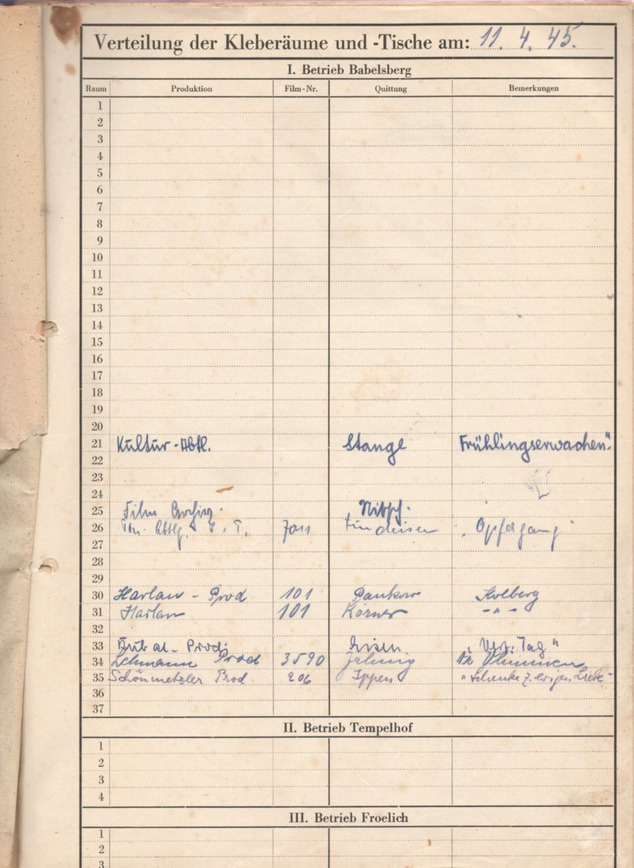
Opfergang had premiered five months earlier, in December, 1944 and Kolberg had premiered on 30 January 1945, so why would these films still be worked on months after their premieres? A film historian in Potsdam has suggsted that "the allocation of the editing tables to productions that are already being rented out may be explained by the wear and tear on the first negative. For color films there was always a second original negative because the demand for copies was so great. Of course, this second negative had to be cut to serve as a new template for copies. That could have been for the foreign versions, but also for the national market, if more copies were needed. The other films mentioned: "The Enchanted Day" (Der verzauberte Tag) was reworked again and again after it was banned in order to bring it to the cinema. Without success. "Veterinarian Dr. Vlimmen" and "Die Schenke zur Ewigen Liebe" both didn't make it to a premiere and remained unfinished. " (The Dr.Vlimmen film, we do know, was in final preparation for music synchronisation, but the film was not completed before the war ended.)
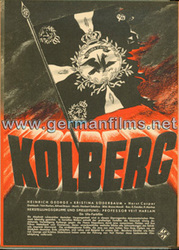
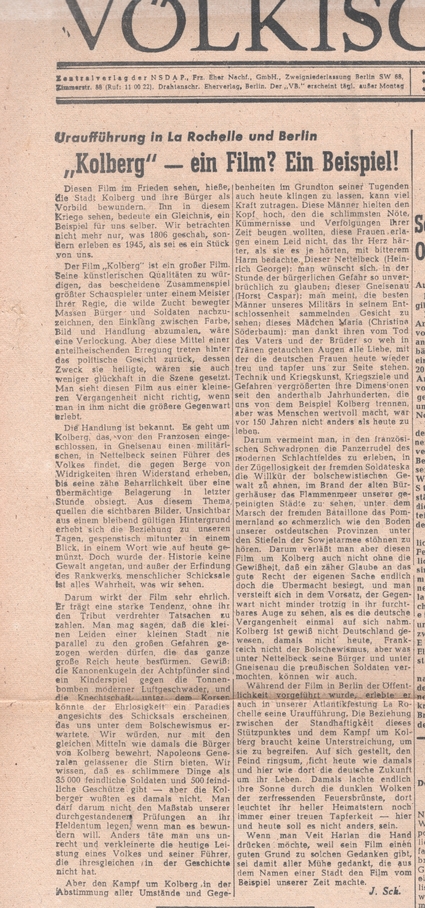
The above film review is translated here:
Premiere in La Rochelle and Berlin "Kolberg" - a film? An example!
Seeing this film in peacetime would mean admiring the city of Kołberg and its citizens as a role model. To see it in this war is a parable, an example for ourselves. We no longer just look at what happened in 1806, but experience it in 1945 as if it were a part of us. The film "Kolberg" is a great film. Appreciating its artistic qualities, the modest interplay of the greatest actors under a master of direction, tracing the wild breeding of agitated masses of citizens and soldiers, depicting the harmony between colour, image and action, would be a temptation, but these means of exhilarating excitement recede behind the political face whose purpose they sanctified, even if they were less happily staged. You don't really see this film from a smaller past if you don't experience the larger present in it. The plot is well known. It is about Kolberg, which, encircled by the French, finds a military leader in Gneisenau and its leader in Nettelbeck, of the people who raise their resistance against mountains of adversity until its tenacious persistence over an overwhelming siege in the last hour prevails. The visible images spring from this theme. Invisibly from a permanently valid background, the relationship to our day arises, sometimes spooky in a look, in a word coined to mean today. Yet no violence was done to history, and apart from the invention of foliage, of human destinies, everything we see is truth. That's why the film seems very honest. It bears a strong tendency without paying tribute to twisted facts. It may be said that the petty woes of a small town must never be paralleled with the great perils which beset the whole great empire today. Certainly: the cannonballs of the eight-pounders are child's play against the barrel bombs of modern air squadrons, and servitude under the Corsican might seem a paradise to dishonor in the face of the fate that awaited us under Bolshevism. Armed only with the same means as the citizens of Kolberg did back then, we would stand up to Napoleon's gene talents more calmly. We know there are worse things than that. There are 35,000 enemy soldiers and 500 enemy guns, but the Kolbergers didn't know it at the time. Therefore one must not apply the standard of the trials we have endured to their heroism if one wants to admire it. Otherwise, one would do us injustice and belittle the current achievement of a people and its leaders, which has no equal in history. But the fight for Kolberg, in the coordination of all circumstances and letting the oddities in the keynote of one's virtues resonate today can bring a great deal of strength. These men held up their heads, which the worst afflictions, sorrows, and persecutions of their time would bow down, these women did not succumb to a feeling of sorrow that their hearts, harder than they ever heard, treated with bitter indignation. This Nettelbeck (Heinrich George): one wishes, at the moment, to believe so steadfastly in the civil danger; this Gneisenau (Horst Caspar): one thinks one sees the best men of our military in his face gathering determination, this girl Maria (Christina Söderbaum): one thanks her eyes, so painfully bathed in tears from the death of her father and brothers, all love, with which the German women are again loyally and bravely at our side today, technology and warfare, war aims and dangers have increased their dimensions since the century and a half that separates us from the Kolberg example, but what makes people valuable was no different 150 years ago than to live today. That is why one thinks one is witnessing the squadrons of tanks of the modern battlefield in the French squadrons, one suspects the arbitrariness of Bolshevik violence in the unrestrained squadron of foreign soldiers, one sees the sea of flames of our tormented cities in the burning of the old historic houses, under the march of the foreign battalions that to hear Pommerland groaning as painfully as the soil of our East German provinces under the boots of the Soviet army. That's why you don't leave this film about Kolberg without the certainty that a tenacious belief in the good right of your own cause will finally conquer the superiority, and you stiffen in the resolve to look the present in the fearful eye no less defiantly, when the German past once took it upon itself. Kolberg was certainly not Germany, not at that time Today, France does not have Bolshevism, but what its citizens were able to do under Nettelbeck and the Prussian soldiers under Gneisenau, we can also do. While the film was being shown to the public in Berlin, it also premiered in our Atlantic fortress of La Rochelle. The relation between the steadfastness of this base and the struggle for Kolberg needs no emphasis to be understood. Left to its own devices, with the enemy all around, the future of Germany is fighting for its life here and there, today as it was then. At that time your sun finally laughed through the dark clouds of devouring conflagrations, there your bright home star still shines with faithful bravery - here and today it shouldn't be any different. If you want to shake hands with Veit Harlan because his film gives a good reason for such thoughts, you have to thank all the effort that made the film the example of our time from the name of a city.
—Völkischer Beobachter, 30. Januar 1945, Berlin. – front page review
The grounds of the Ufa Babelsberg studios being cleared of debris after the Soviets overran it on April 24, 1945:
